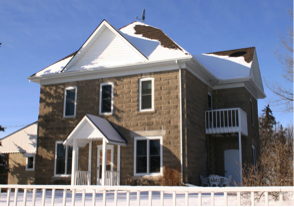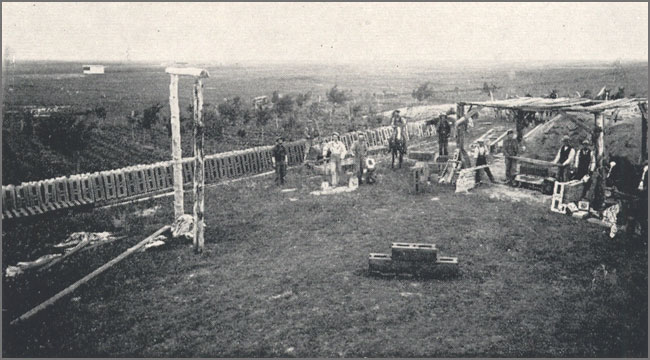Concrete Blocks
 At first glance this attractive house on a farm near Boissevain looks like it might be one of the many fieldstone homes in the region. A closer look tells us that those building blocks are concrete. For a few years in the early 20th century, many buildings in southern Manitoba were built with locally cast concrete blocks. Much larger than bricks, the blocks were hollow, and were typically flat on the interior face but variously patterned on the exterior face. Because these blocks did not require high-temperature firing like bricks, there was no need for the substantial infrastructure used in conventional brick-making. They could be made on the building site with portable equipment.  Cement Block Manufacturing on the farm of W.J. McKinney, 1904 – Photo courtesy Mrs. Ina McKinney Beckoning Hills, page 73. It all began with the patent in 1900 for H.M. Palmer’s block machine. Within a few years, this new technology really caught on. It appears that the firm of Laird & McGarvey of Deloraine were one of the first in the region to purchase a machine to make the bricks. Aside from the advantage of making your building material on site with locally available materials, by using a variety of molds one could produce an attractive and durable exterior. By altering the type of sand used you can get a bit of variety in colour and texture.  Some builders used unique designs for effect and emphasis. How Blocks Are Made The cement is poured into a mold arranged with the outside surface (in various patterns) at the bottom. Depressed end pieces are put in to make the blocks partly hollow. When the mold is half filled, a metal block known as the “core” is placed in position. The mold is then filled to the top and tamped. It hardens quickly under the pressure and may be taken from the mold at once. The “core” is then removed, leaving the blocks hollow.  A supply of Concrete Blocks in Napinka. Many of the buildings are still standing and looking good in towns across our region. They range from fine heritage homes, old schools, and commercial buildings like this one in Lyleton.  An example in Lyleton Historians aren’t sure why the use of concrete blocks was popular only for a short while, with most examples being from 1904 to 1910. Perhaps with improved rail access, the availability and quality of both wood siding and bricks were a more attractive option? Perhaps the uniform grey colour was not as appealing?  Note the date stone on this Telephone Office in Waskada. Although there are examples of concrete block buildings from later in the century, they are rare. More Examples If we take a look at how so many of these buildings have survived in good shape we can see it was a good practical choice for the times. So if you are passing though our southwestern Manitoba towns, look for these examples.  Union Bank Building in Waskada – built 1906  The Crerar Law Office in Melita, as it appeared in 1904 when it was built. Still used today.  |


